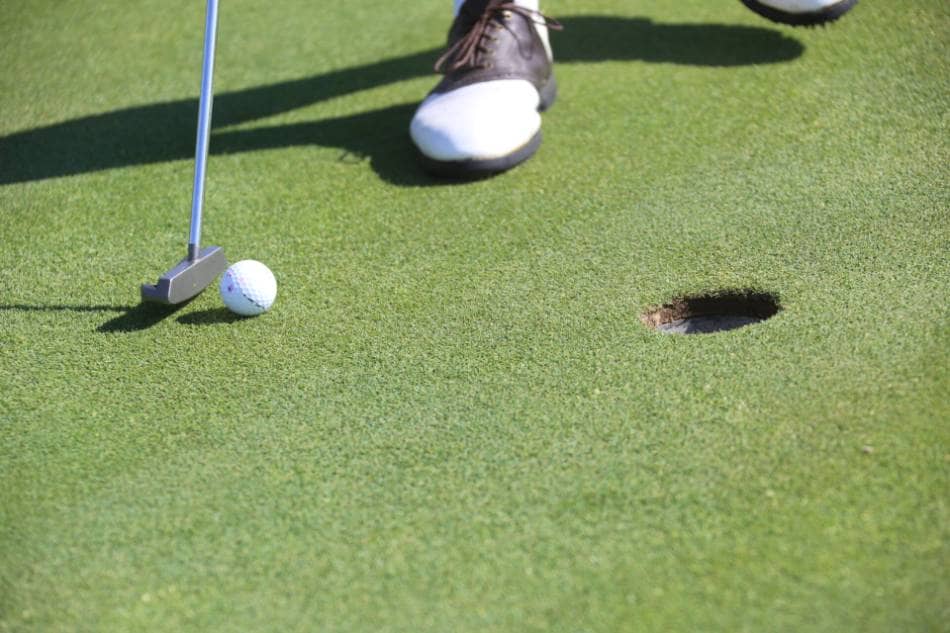
For new golfers, learning the intricacies of the game is ‘par for the course’. In fact, the word par is one of the most frequently used words in golf. So, understanding what par is and how to make one is vital to any person’s success in the game of golf.
So, what is par in golf?
Par in golf is the standardized score for any hole relative to the hole’s total length. The shorter the hole’s distance, the lower the par. Par is also a term used to describe a golfer’s score that is equal to the par for the hole. The Par for an 18-hole course is usually 72.
Each hole on a course has a par and the sum total of each hole’s par equals the par for the entire golf course. A typical golf course has 18 holes with a mix of par 3’s, par 4’s, and par 5’s.
The most common mix is four Par 3’s (12 strokes), ten Par 4’s (40 strokes) and four Par 5’s (20 strokes) equaling 72 total strokes for par.
Distribution of how par 3’s, 4’s, and 5’s is laid out over a golf course is up to the golf course architect in the design and construction phase of building a golf course. Par for any hole is determined by its relative playing length and the generalized way to achieve a par for any hole is as follows:
- Par 3 – 1 shot from the teeing ground onto the green followed by two putts into the hole.
- Par 4 – 1 shot from the teeing ground, 1 approach shot onto the green, followed by two putts into the hole.
- Par 5 – 1 shot from the teeing ground, 2 approach shots to get onto the green, followed by two putts into the hole.
The above generalizations are not how every golfer makes par but it does provide a baseline understanding for the logic behind the number chosen for each type of hole.
Is Par Good in Golf?
Yes, a par in golf is good because the vast majority of golfers struggle to make par consistently. According to the National Golf Foundation, the average 18-hole score for a round of golf is about 100, almost 30 strokes more than the typical par for a course, 72.
This means the average golfer’s score for any hole will typically be greater than one shot above par.
Even harder than making par is recording a score that is under par. The goal of golf is to get the ball into the hole in as few strokes as possible. Since a majority of golfers consistently record scores higher than par, anything at or below par is a very good score.
What Is a Scratch Golfer?

A golfer who averages close to a score of par on each hole is called a scratch golfer.
Becoming a scratch golfer is very hard and requires a lot of skill, patience, and dedication to constantly refining one’s golf swing and strategy for playing the game.
All touring professional golfers are scratch golfers but not all scratch golfers are touring professionals.
Conversely, a golfer who averages a score of one stroke over par, a score called a bogey, is known as a bogey golfer.
Where Does the Word Par Come From?
The word par did not originate as a golf term. Par is a term used in the financial industry to describe the baseline value or par value of a bond. The first use of par in golf dates back to the 1870 British Open Championship held at Prestwick Golf Club in South Ayrshire, Scotland.
Golf writer AH Doleman asked two of the tournament’s competitors what they thought the winning score for the championship would be.
They replied that optimal play at Prestwick (which had only 12 holes at the time) should result in a score of 49, of which Doleman referred to this score as Prestwick’s par.
Young Tom Morris won the 36-hole tournament (three rounds of 12 holes each equals a par of 147) with a score of 149, two strokes over par.
How Is Par Determined in Golf?
The United States Golf Association provides the following recommendations for par based on the playing lengths of each type of hole:

These parameters are not written in stone as there are par 3’s with distances over 260 yards and par 4’s with distances over 490 yards. The only difference is most golfers playing holes that long are professionals who are good enough to hit the ball that far.
The average driving distance (golf ball hit with a driver) for male amateur golfers is only 217 yards. For comparison, the average driving distance for male professional golfers on the PGA TOUR for the 2021 season is just under 300 yards at 295.9 yards.
When considering the previous information, it would seem silly for a golfer to play from a set of tees where they cannot consistently reach the green in one shot on a par 3, two shots on a par 4 or three shots on a par 5.
This is why it is recommended that golfers look at the golf course scorecard before play begins to see the lengths of each hole on the course. This allows the golfer to find the right set of tees that fits their skills and abilities the best.
Let’s return to Prestwick Golf Club to look at their scorecard, which offers four separate teeing grounds for golfers to play from: Championship, Medal, Senior/Ladies, and Ladies (listed by distance longest to shortest).
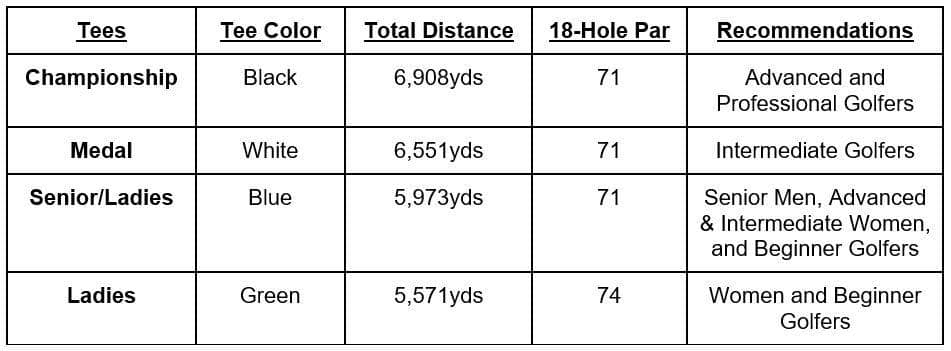
The recommendations are provided as a guideline for golfers to follow. Hard golf is not fun golf, especially when golfers require a lot of swings to get the ball in the hole.
So next time you go to the golf course try playing from a tee box forward from where you normally play to see if your score is lower and if you have more fun.
Can Par on a Hole Be Different for Men and Women?
Yes, par can be different for men and women on the same golf course. Let’s return to the Prestwick scorecard for further explanation. As you can see above, the Championship, Medal, and Senior/Ladies teeing grounds are each Par 71 while the Ladies tees have a par of 74.
This is because the Ladies’ tees have three holes that play as par 5’s (the 7th, 9th, and 13th holes) instead of a par 4 like the other tees.
Each of these three holes come in at just over 400 yards putting them on the threshold of either a par 4 or par 5, based on the USGA’s recommendations above. The most likely reason behind making these holes par 5’s is their difficulty.
The par of a hole can also vary during a golf tournament. Tournament officials have the power to alter the layout of the golf course by changing the par of a hole thus requiring the tournament’s competitors to play from a different tee box.
For example, ABC Country Club is hosting a PGA TOUR tournament this week. The 7th hole is a par 5 with four varying tee box distances of 597 yds, 583 yds, 525 yds, and 486 yds.
The tournament official could opt to move play from the back tee box (597 yds – length of an average par 5) up to the forward tee box (486 yds – length of a longer par 4) and turn the hole into a par 4.
There are several reasons a tournament official might do this but one popular reason is to make the hole harder.
Shortening the hole may bring hazards (water or bunkers) into play that wouldn’t normally affect a player’s strategy for navigating the hole when playing 100 yards further back.
Is Par Always 72?
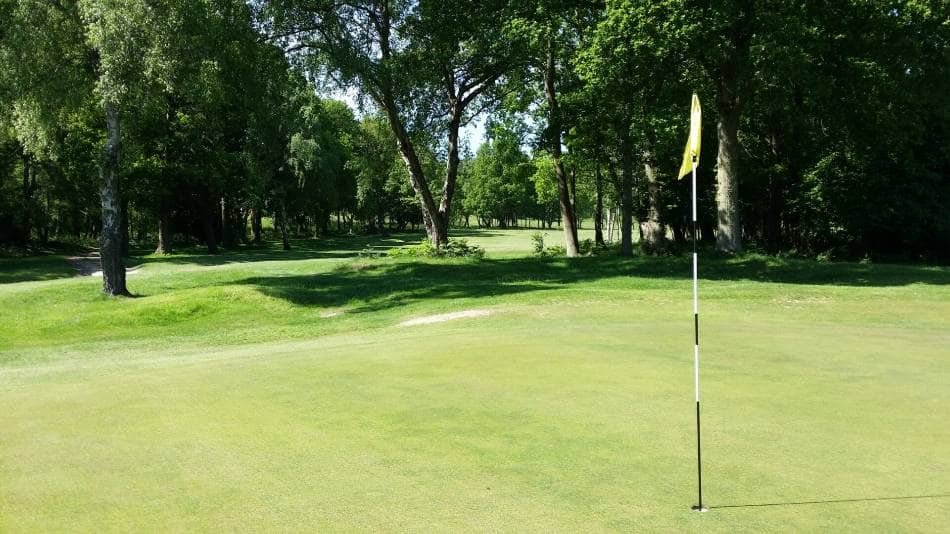
As proven with the previous example, par is not always 72 for a golf course. Like fingerprints, snowflakes, and people, no two golf courses are identical. Each golf course is built around, on top of, and into the surrounding geographic landscape.
The golf course architect must work with the plot of land provided to create an interesting and challenging layout.
Par vs Birdie vs Bogey
As you have learned so far, a score of par is equal to the standard number of strokes a golfer should take to get the ball in the hole from start to finish.
A birdie meanwhile is the name for a score that is one below par and a bogey is a score that is one above par. A birdie is a better score than par by one stroke and a better score than a bogey by two strokes.
Is There a Par 6 in Golf?
Yes, there are Par 6’s in golf but they are rare. As shown above, the guidelines provided by the USGA recommend that any hole over 670 yds for men and 570 yds for women be considered a par 6.
Ultimately, it is up to the golf course architect or operator to determine the par for each hole and the course. The longest par 6 hole on record is located in Marquette, Michigan at Chocolay Downs and measures out to 1,007 yards.
Is There a Par 7 in Golf?
Yes, the longest golf hole in the world, located at Gunsan Country Club in South Korea, is a Par 7 that measures almost 1,100 yds. Joining the 3rd hole at Gunsan Country Club is the 964 yard, par 7 at Satsuki Golf Course in Sano, Japan.
How to Make More Pars in Golf?
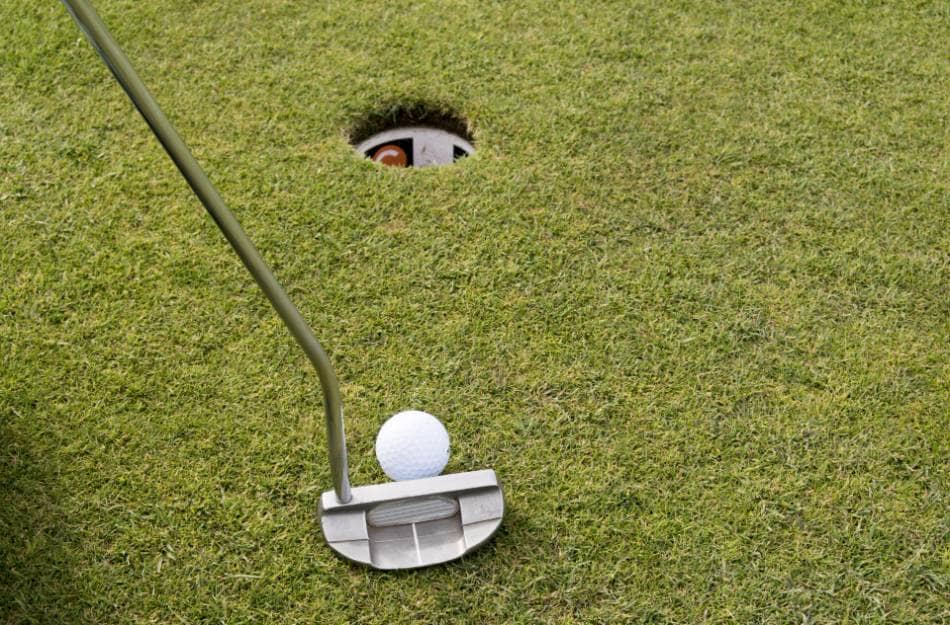
Pars can be hard to come by for beginning golfers because their swings are often wildly inconsistent and they lack the experience necessary to develop a strategy for playing any golf course as well as the knowledge of how to hit certain types of shots.
With that in mind, let’s look at a few tips to help beginners make more pars:
- Play from the Forward Tees…or Even from the Fairway – It’s no secret that golf is a hard game and it gets exponentially harder the longer the hole becomes. If you are just getting started in the game and have less than 10 rounds of golf under your belt, make it easy on yourself and play from the forward most tee box. If you still struggle to make par from here, try teeing it up and starting play from the middle of the fairway. You can play par 3’s from 50-75 yards, par 4’s from 125-150 yards, and Par 5’s at 200-225 yards. Once you start to make par consistently from this distance, move back until you play every hole from the forward most tee box. Remember, you wouldn’t ask a 7-year-old child just learning how to play baseball to play their first game in Yankee Stadium. So why ask a beginning golfer (no matter their age) to play a golf course that is over 6,000 yds long?
- Tension Is a Killer – Beginner golfers often think power in golf comes from gripping it and ripping it because that’s what the professionals do. However, tension in the hands from gripping the club too tight is a major swing flaw for beginning golfers. On a scale of 1-10 (lightest to firmest), hold the club at about a 4 for a full swing shot. Basically, pretend you are holding a baby bunny and you do not want it to get away but you also don’t want to hurt it. Gripping the club too tight limits the mobility of the muscles that control the wrists, hands, and fingers not allowing the club head to rotate during the swing. Just like walking with your legs flexed makes you walk like Frankenstein, gripping the club too hard with your hands will strangle your ability to hit the ball consistently.
- Take a Lesson – Many public golf facilities offer group lessons for beginner golfers that review the basics in a friendly, unintimidating setting. One-on-one time is limited with the instructor but having a friend to laugh with when you hit a horrible shot makes the game more fun. Group lessons also offer a way to meet other golfers with similar skill levels that may just become your new tee time partner.
Besides Par, What Are Other Scores in Golf Called?
Now that you know what par in golf is, let’s review some other golf scoring terms. Here they are listed from lowest under par to highest above par:
- Condor – A score of 4-under par, occurring as an ace or hole in one on a par 5 or a score of 2 on a par 6.
- Albatross or Double Eagle – A score of 3-under par, occurring as a hole in one on a par 4, a 2 on a par 5, or a 3 on a par 6.
- Eagle – A score of 2-under par, an example is a score of 3 on a par 5 or also known as a hole in one on a par 3.
- Birdie – A score of 1-under par, such as a score of 3 on a par 4.
- Par – A par is a score equal to the number of strokes designated on the hole, i.e. a score of 3 on par 3.
- Bogey – A score of 1-over par.
- Double Bogey – A score of 2-over par or a 7 on a par 5, for instance.
- Triple, Quadruple, or Quintuple Bogey – As the names imply, these are scores of 3, 4, and 5-over par respectively.
Here is a chart that visually correlates scores with their names for each type of hole par.
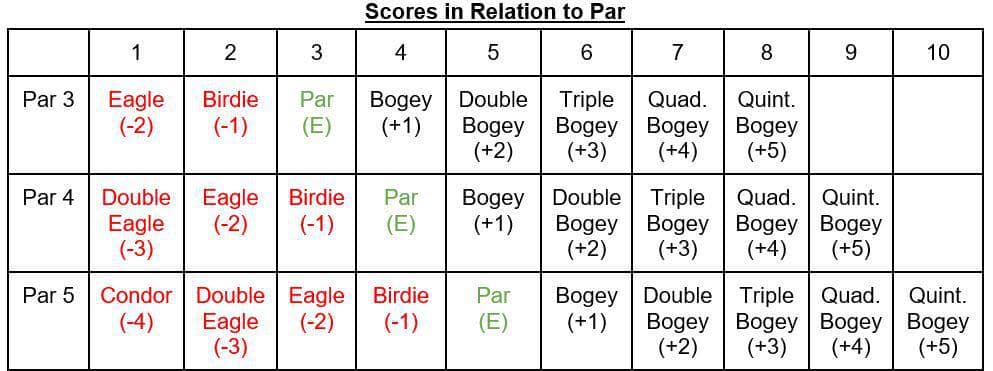
Why Are Scores Under Par Red and Scores Over Par Black?
When scores are recorded or displayed on a scoreboard at a golf tournament they are shown in different colors to help the fan better recognize scores in relation to par.
Similarly, in the business world, a company that is said to be ‘in the red’ is considered to have negative earnings while a company ‘in the black’ makes positive earnings.
Relating it to golf, a red number means the score is below or negative of par while a black number means the score is above or positive of par. A green number reflects a score of even par.
